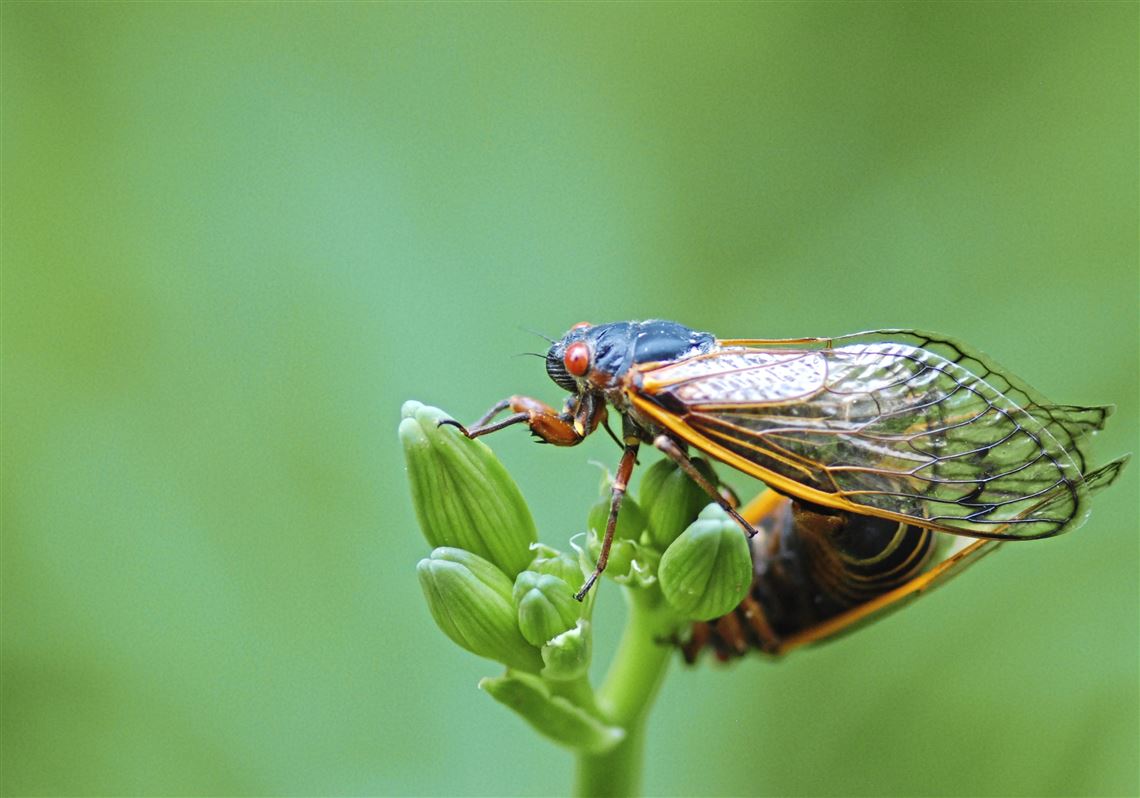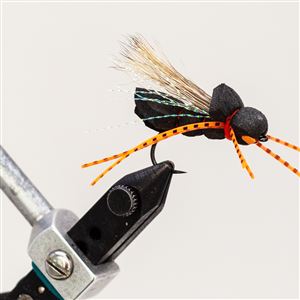It’s easy to find evidence that the 17-year cicadas’ mating season has begun in Western Pennsylvania. Exoskeletons hang on tree branches, stray wings left by predators lie in the grass and, when it’s hot enough, unlucky males still searching for mates sing their ringing, high-pitched song.
Despite the beady, red-eyed bugs’ appearance, most people interviewed Tuesday said they don’t mind the noisy visitors.
Amy Walsh, 62, estimates there were thousands in her yard in Bradford Woods last weekend. She’s become accustomed to being surrounded by the insects and their songs while she tends to her front-yard gardens.
“It’s fun because they’re not dangerous,” she said, picking up one by its thorax.
She threw the insect into the air and smiled as it unfurled its wings, flew briefly and landed in the grass by the nearest tree. “They’re harmless.”
Contractor Lee Lansberry was at work Tuesday afternoon repairing a chimney on a house in Sewickley. His crew had seen several cicadas on the roof that day, he said.
“They don’t really bother us,” he said. “I think it’s fascinating.”
Mr. Lansberry said he was most intrigued by the cicadas’ fluctuating buzzing, which seemed to grow and diminish in volume over the course of the day. Sure enough, scientists have found that cicadas’ calls vary in intensity depending on the temperature.
Brood VIII periodical cicadas last emerged here in 2002. They exist only in the Northeast and spend most of their 17 years underground, sustaining themselves by drinking the sap of large trees and bushes.
“That’s their life. This is only for reproduction,” said Julia Schwierking, an environmental educator at Fern Hollow Nature Center in Sewickley Heights.
Cicadas emerge in the nymph stage, with translucent shells and pale white bodies, and quickly break out of their exoskeletons to let their wings dry. During this one- to two-hour period, their bodies darken and their skin hardens.
The males use their wings for the first time to fly from their molting places and begin their mating ritual.
“The boys are up there singing, calling to the females,” Ms. Schwierking said.
Using a special sound-producing organ in their abdomen called a tymbal, the males produce distinct choruses to attract females. After mating, the females use rigid abdominal muscles to scrape grooves in tree branches where they deposit a couple dozen fertilized eggs in each groove. In her brief life above ground, a female may lay up to 600 eggs.
After the eggs hatch, young cicadas begin feeding on tree fluids until they drop to the ground to burrow. They spend the next 17 years underground feeding and maturing. The adults, having finished their life cycle, usually die within one to two months.
Perhaps the biggest unknown is whether cicadas signal to each other that it’s time to emerge. This is a prime topic of research for cicada expert Gene Kritsky, dean of behavioral and natural sciences at Mount Saint Joseph University in Cincinnati.
“We don’t have any evidence that the cicadas are talking to each other under the ground,” he said.
Temperature and moisture seem to be their alarm clocks. “When the soil is 64 degrees 4 inches below the surface … couple that with a nice, soaking rain and you’ll have big emergences.”
Mr. Kritsky’s research led him to develop an app called Cicada Safari, which allows users to post geotagged photos of where they encounter cicadas. This type of citizen science, he hopes, will bring people closer to his favorite creatures.
“They are bugs of history,” he said. “You’ll never forget a cicada emergence.”
Michael Skvarla, an entomologist at Penn State University, agreed. He frequently gets calls from people wondering what they can do to keep cicadas from invading their property.
“Sometimes the sound can be annoying, but honestly, there’s not a whole lot to do but appreciate that this is a rare event.”
The cicadas’ drone is inescapable at Fern Hollow Nature Center, where Ms. Schwierking has been showing off the critters to the curious kids who visit. After some initial fear, most warm up to the cold-blooded bugs.
“They’re like, ‘Oh, that’s really cool.’ Next thing you know, they’re holding them, and they’re like, ‘Can I take this home?’”
Some people who remember Brood VIII’s last emergence say this year’s pales in comparison. Jim Esperseth of Murrysville said he’s encountered plenty this season — but far fewer than in 2002. “It was a din that you could hardly even escape.”
Colby Smith, 63, of Warrendale, said she isn’t bothered by the cicadas in her garden in Bradford Woods — except when they land on her back.
“One dropped down, half body and half exoskeleton, still metamorphizing,” she said.
Last week, she had to take a break from gardening because she couldn’t stand the smell of decomposing cicada shells. Still, Ms. Smith said, she doesn’t mind the insects — particularly the sound.
“It’s quite amazing how they do it. They’re even all singing the same key!”
Christian Snyder: csnyder@post-gazette.com and Nick Garber: ngarber@post-gazette.com.
First Published: June 5, 2019, 8:44 p.m.
Updated: June 9, 2019, 8:37 p.m.


















